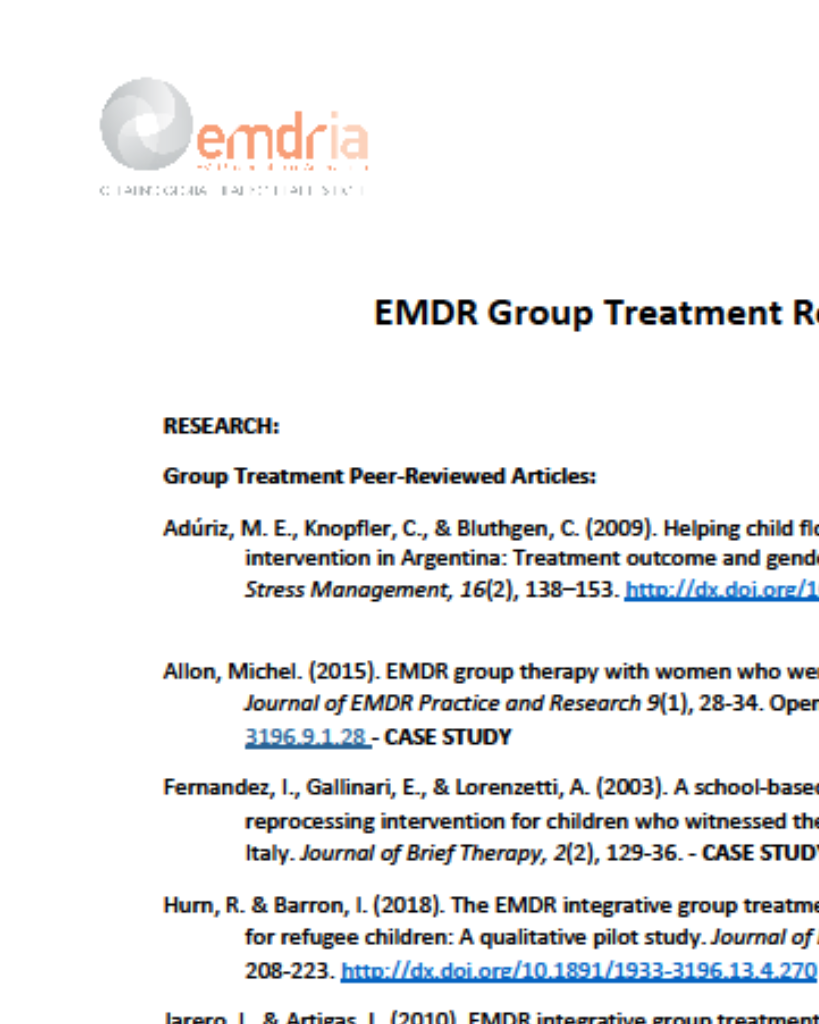Comparative Efficiency of EMDR and Prolonged Exposure in Treating Posttraumatic Stress Disorder: A Randomized Trial
Comparative treatment efficiency of EMDR therapy and prolonged exposure (PE) therapy was tested for 20 participants diagnosed with PTSD.
Article Abstract
“The comparative treatment efficiency of eye movement desensitization and reprocessing (EMDR) therapy and prolonged exposure (PE) therapy for the treatment of posttraumatic stress disorder (PTSD) was tested for 20 participants diagnosed with PTSD. Efficiency was operationalized as the total exposure time to traumatic memories during and between sessions; the number of trauma memories processed over the course of therapy; how many sessions were required to resolve the primary trauma; and lower subjective units of disturbance (SUD) levels after the initial treatment session. Participants were randomized to each condition and received 12 90-minute sessions of therapy over 6 weeks. Symptoms were assessed by treatment-blind assessors at posttreatment, and at 3 and 6 months follow-up. Results demonstrated a significant decrease in symptoms posttreatment for PTSD (d = .64), depression (d = .46), anxiety (d = .52) and stress (d = .57) for both groups, which was maintained at 3 months. At 6 months there was a small increase in symptoms compared to the 3-month time point on the Clinician-Administered PTSD Scale (CAPS) but no significant change in any self-report symptoms EMDR was significantly more efficient than PE. EMDR participants had less total exposure time to traumatic memories when homework hours were included (d = .66), reported lower SUD scores after the first session (d = .45), required fewer sessions for the target memory to decrease to near zero distress levels (d = .84), and processed more traumatic memories.”
—Description from publisher
Article Access
Open Access
McGuire Stanbury, T. M., Drummond, P. D., Laugharne, J., Kullack, C., & Lee, C. W. (2020). Comparative Efficiency of EMDR and Prolonged Exposure in Treating Posttraumatic Stress Disorder: A Randomized Trial. Journal of EMDR Practice and Research, 14(1), 2–12. https://doi.org/10.1891/1933-3196.14.1.2
About the Journal
The Journal of EMDR Practice and Research is a peer-reviewed publication devoted to integrative, state-of-the-art papers about Eye Movement Desensitization and Reprocessing. It is a broadly conceived interdisciplinary journal that stimulates and communicates research and theory about EMDR, and their application to clinical practice. The Journal of EMDR Practice and Research is the Official Publication of the EMDR International Association.
Date
March 1, 2020
Creator(s)
Tracy M. McGuire Stanbury, Peter D. Drummond, Jonathan Laugharne
Contributor(s)
Claire Kullack, Christopher W. Lee
Topics
PTSD
Practice & Methods
Comparative Studies
Extent
11 pages
Publisher
Springer Publishing Company
Rights
Copyright © 2020 EMDR International Association
APA Citation
McGuire Stanbury, T. M., Drummond, P. D., Laugharne, J., Kullack, C., & Lee, C. W. (2020). Comparative Efficiency of EMDR and Prolonged Exposure in Treating Posttraumatic Stress Disorder: A Randomized Trial. Journal of EMDR Practice and Research, 14(1), 2–12. https://doi.org/10.1891/1933-3196.14.1.2
Series
14
Installment
1
Audience
EMDR Therapists
Language
English
Content Type
Article, Peer-Reviewed, RCT
Original Source
Journal of EMDR Practice and Research
Access Type
Open Access





